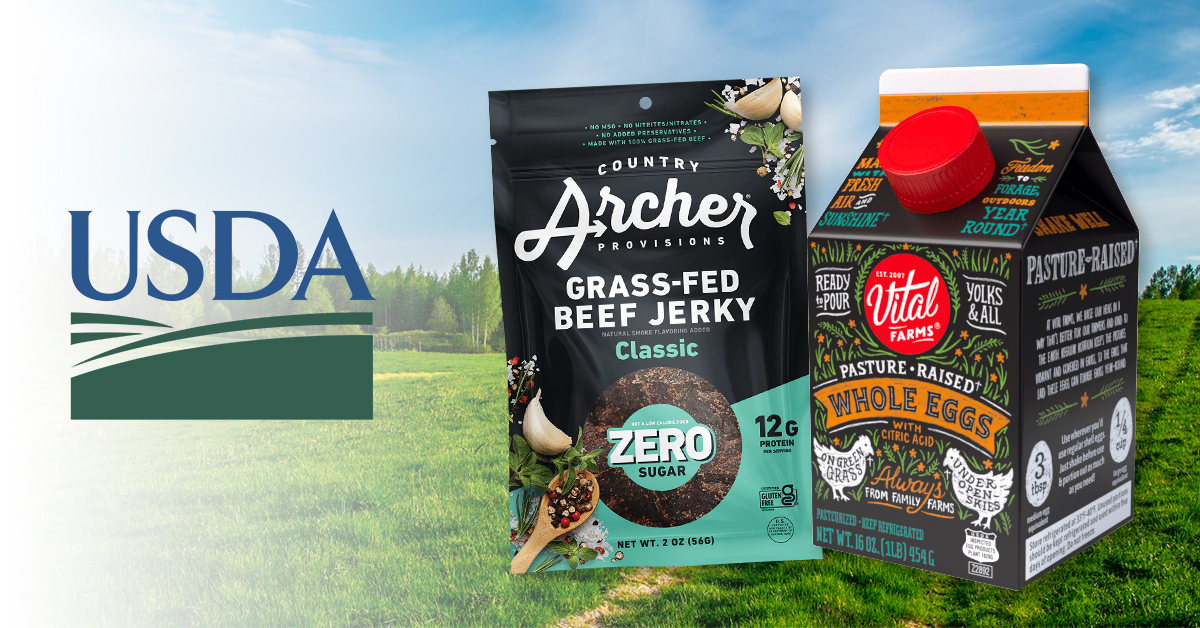USDA Prioritizes Labeling Claims For Humanely-Raised Animal Products

The U.S. Department of Agriculture announced the launch of a new effort to regulate animal-raising claims on Wednesday, a move that could impact how CPG brands use the terms “grass-fed,” “free-range” or “raised without antibiotics” on food labels. News of the announcement was well received by some brands, who believe these terms should have stricter oversight.
The labeling initiative is part of a larger effort by the USDA’s Food Safety and Inspection Service’s (FSIS) to clarify and modernize oversight of false and misleading labels.
The USDA oversees meat (beef, pork and other animal protein), poultry and processed egg products (liquid eggs) as well as some packaged goods made with these ingredients. The current reevaluation of labeling claims does not encompass shell eggs or dairy products like cheese, yogurt or milk as those categories fall under the Food and Drug Administration’s (FDA) purview.
FSIS is hoping to revise the current guidelines for animal-raising claims by the end of the calendar year, USDA Deputy Under Secretary for Food Safety Sandra Eskin told NOSH. Part of the impetus to do so, she added, is to help consumers better understand what these attributes mean and ensure companies are, in turn, properly meeting these standards.
“We are revising this guideline document because we want to strengthen the substantiation standards,” she said. ”We [want to] send a clear signal to companies that the current system perhaps is not robust enough.”
Under the current framework, terms like “grass-fed” and “free-range” are considered voluntary marketing claims that go through a FSIS approval process that includes submitting documentation to the Labeling Program and Delivery Staff. If Wednesday’s announcement is indicative of future changes, not only would brands need to meet certain standards in order to use these claims on their packaging, but also would have to provide more information to the USDA in order to substantiate them. The USDA was not able to provide details on what the process would entail or how the approval procedure would change.
The first step in this process is revising the animal-raising guidelines that were most recently updated in 2019. In that version, information was added to the use of “Free Range” and related claims like “Free Roaming,” “Pasture Fed” and “Pasture Raised.” It also updated the various terminology that is used when a product claims to not use antibiotics (adding “Raised Antibiotic Free” and “No Added Antibiotics”) to its guidelines.
For the time-being, the USDA is “strongly encouraging” – but not requiring – food makers who would fall under the USDA’s oversight to use third-party certification bodies for many of these claims.
In order for the USDA to require third party certification, as opposed to simply encouraging it, the agency would need to undergo the formal process of rulemaking under USDA FSIS oversight. Though that process could take years due to a required notice and comment period for stakeholders to weigh in, it’s not to say that the agency would not consider rulemaking in the future, Eskin said.
Secondarily, FSIS will be under-going its own exploratory testing of products claiming to not contain antibiotics that may lay the groundwork for a future antibiotic-free verification program.
The impact on brands is yet to be determined but for the many CPG food companies like jerky brand Country Archer, bone broth producer Kettle & Fire or pastured egg business Vital Farms – that have built brand identity on claims such as grass-fed, pasture-raised or antibiotic-free – new regulations with heightened transparency behind them could ultimately increase consumer confidence.
It is unclear if this reevaluation will include environmental claims like “low carbon beef” or “regeneratively raised” meat, Eskin said.
Jeff Tripician, CEO at Grass Fed Foods, applauded the news saying it gave “teeth” to on-label claims. The company was formed when Teton Waters Ranch merged with SunFed Ranch in order to expand their respective distribution and capitalize on increased consumer demand for pasture-raised meat.
“Consumers’ ability to trust the label and its claims strengthens our brand and business, and our ability to pay ranchers for all their hard work,” Tripician said. “While we do not need the government to police the claims for our brands, it is critical to force other brands that exaggerate or mislead consumers to be held accountable – undermining consumer confidence hurts the industry and all those that take the high path of integrity and ethics.”
Although Grass Fed Foods was encouraged by the news, Tripician did express concern that the USDA may not ultimately require third-party certification of these types of claims but rather continue to “strongly encourage” them, as the new directive states. Tripician pointed to the fact that many “grass-fed” food brands use animals that are still grain-finished (fed grains for the last three-to-six months before processing), misleading consumers to believe that the animals are fed grass for their entire lives.
“This issue is more than a labeling issue, it is an integrity issue. Consumers receive messages from multiple sources – websites, packaging, advertisements, etc – all should be judged in a manner that allows consumers to trust the brand author,” he said.
In recent years, both the USDA and the Food and Drug Administration (FDA) have embarked on a multi-pronged departmental approach to overhauling food labeling guidelines and enforcement. The USDA has been in the process of defining “healthy” label claims and while the FDA recently revised its rule on salt substitutes, the agency has also been criticized for not prioritizing front-of-pack labeling.
“Consumers should be able to trust that the label claims they see on products bearing the USDA mark of inspection are truthful and accurate,” said USDA Secretary Tom Vilsack in a prepared statement. “USDA is taking action today to ensure the integrity of animal-raising claims and level the playing field for producers who are truthfully using these claims, which we know consumers value and rely on to guide their meat and poultry purchasing decisions.”


















